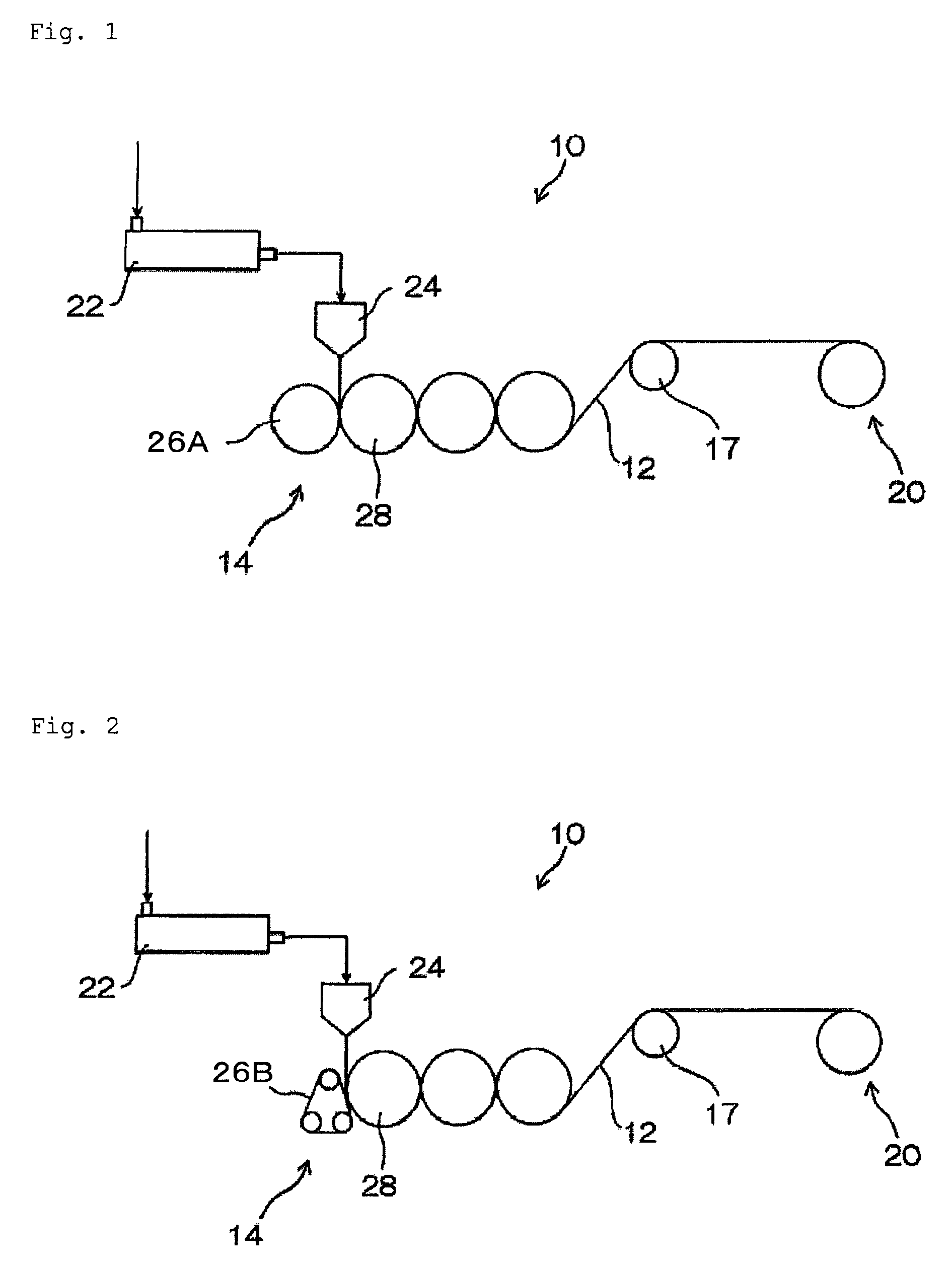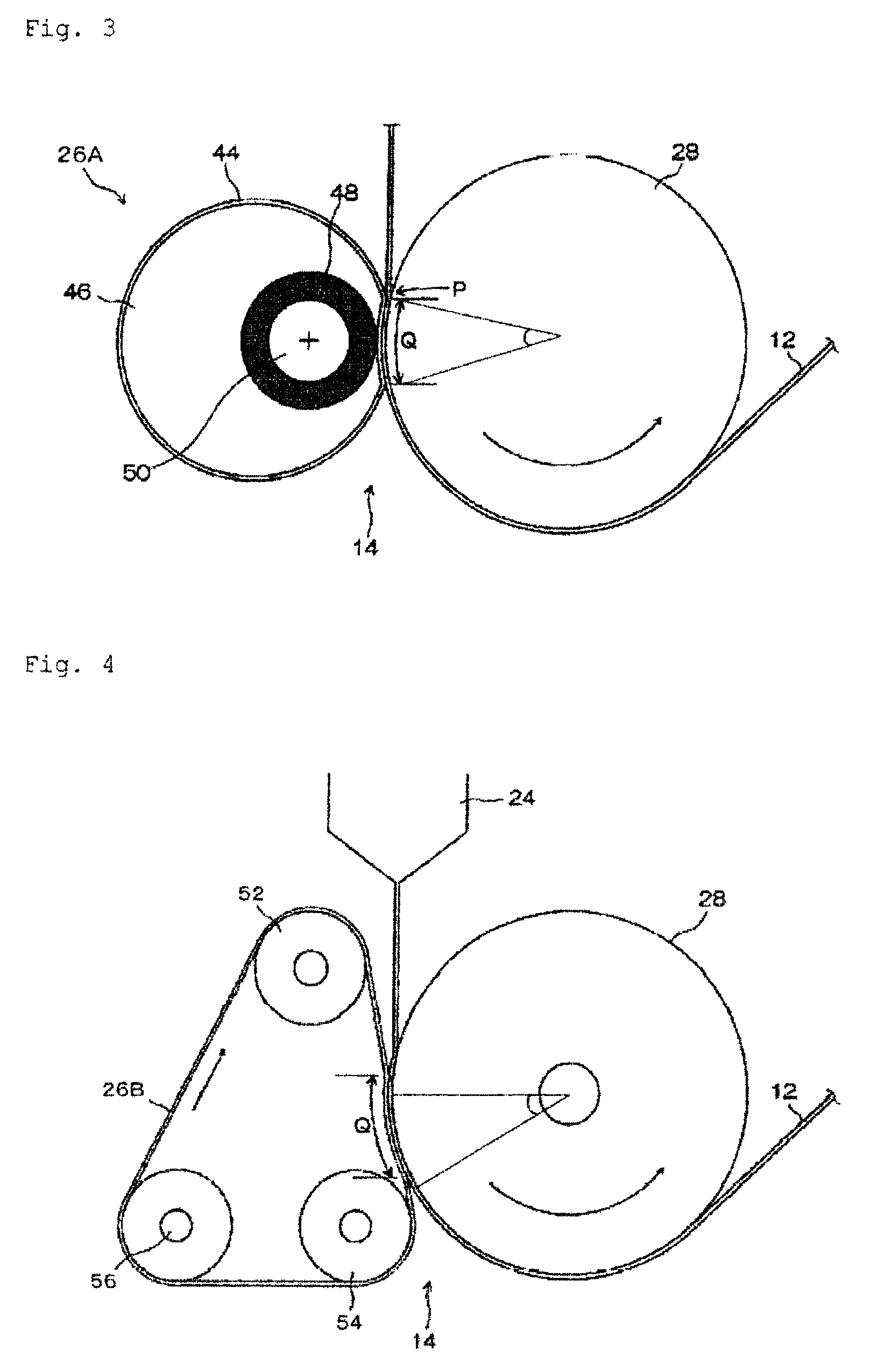Method of producing a thermoplastic film
a thermoplastic film and production method technology, applied in the field of thermoplastic films, can solve the problems of inability to completely prevent the release of organic solvents, surface smoothness, accuracy fluctuation, etc., and achieve the effects of stable production, well-balanced condition, and surface smoothness
- Summary
- Abstract
- Description
- Claims
- Application Information
AI Technical Summary
Benefits of technology
Problems solved by technology
Method used
Image
Examples
production example 1
Production of Cellulose Acetate Propionate (CAP1):
[0430]80 parts by mass of cellulose (linter) and 33 parts by mass of acetic acid were put into a reactor equipped with a stirrer and a condenser, and processed at 60° C. for 4 hours to activate the cellulose. 33 parts by mass of acetic anhydride, 518 parts by mass of propionic acid, 536 parts by mass of propionic anhydride and 4 parts by mass of sulfuric acid were mixed and cooled to −20° C., and added to the reactor.
[0431]This was esterified at a maximum reaction temperature of 35° C., and the time at which the viscosity of the reaction liquid reached 840 cP (0.84 Pa·s) was the end point of the reaction. The system was so controlled that the temperature of the reaction mixture at the end point could be 15° C. A mixture of 133 parts by mass of water and 133 parts by mass of acetic acid was cooled to −5° C. to prepare a reaction stopper, and this was added to the reactor so that the temperature of the reaction mixture could not exceed...
production example 2
Production of Cellulose Acetate Butyrate (CAB1):
[0434]200 parts by mass of cellulose (wood pulp) and 100 parts by mass of acetic acid were put into a reactor equipped with a stirrer and a condenser, and processed at 60° C. for 4 hours to activate the cellulose. 161 parts by mass of acetic acid, 449 parts by mass of acetic anhydride, 742 parts by mass of butyric acid, 1349 parts by mass of butyric anhydride and 14 parts by mass of sulfuric acid were mixed and cooled to −20° C., and added to the reactor.
[0435]This was esterified at a maximum reaction temperature of 30° C., and the time at which the viscosity of the reaction liquid reached 1050 cP (1.05 Pa·s) was the end point of the reaction. The system was so controlled that the temperature of the reaction mixture at the end point could be 10° C. A mixture of 297 parts by mass of water and 558 parts by mass of acetic acid was cooled to −5° C. to prepare a reaction stopper, and this was added to the reactor so that the temperature of ...
example 1
Formation of Unstretched Thermoplastic Film 1:
(1) Additives to Cellulose Acylate:
[0438]The following additive composition was used as in Table 1 below. The amount of each additive is in terms of part by mass of the additive relative to 100 parts by mass of the resin to which it is added.
[0439]
Composition 1Stabilizer: Sumilizer GP (by Sumitomo Chemical)0.2parts by massStabilizer: Adekastab AO-80 (by Asahi Denka Kogyo)0.15parts by massStabilizer: Adekastab 2112 (by Asahi Denka Kogyo)0.15parts by massUV absorbent: Adekastab LA-31 (by Asahi Denka Kogyo)1.1parts by massFine particles: silica particles having a mean primary particle0.05parts by masssize of 1.2 μm (the proportion by mass of 0.9 to 1.5 μm particlesis at least 95%; and that of larger particles than 1.5 μmparticles is at most 1.0%)Composition 2Stabilizer: Adekastab AO-60 (by Asahi Denka Kogyo)0.2parts by massStabilizer: Adekastab PEP36 (by Asahi Denka Kogyo)0.2parts by massStabilizer: Adekastab O-180A (by Asahi Denka Kogyo)1p...
PUM
| Property | Measurement | Unit |
|---|---|---|
| surface roughness | aaaaa | aaaaa |
| aspect ratio | aaaaa | aaaaa |
| aspect ratio | aaaaa | aaaaa |
Abstract
Description
Claims
Application Information
 Login to View More
Login to View More - R&D
- Intellectual Property
- Life Sciences
- Materials
- Tech Scout
- Unparalleled Data Quality
- Higher Quality Content
- 60% Fewer Hallucinations
Browse by: Latest US Patents, China's latest patents, Technical Efficacy Thesaurus, Application Domain, Technology Topic, Popular Technical Reports.
© 2025 PatSnap. All rights reserved.Legal|Privacy policy|Modern Slavery Act Transparency Statement|Sitemap|About US| Contact US: help@patsnap.com



